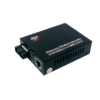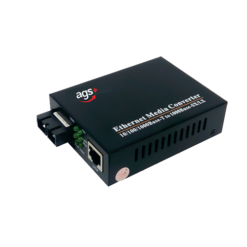Media Converter AGS-MC1312-20
Media Converter AGS-MC1312-20
10/100/1000M SM Dual Fiber,
1310nm, SC, 20Km
Media Converter AGS-MC1312-20 is a critical networking device that facilitates the integration of different types of network media, acting as a bridge between disparate communication technologies. Its primary function is to convert signals from one media type to another, enabling seamless connectivity between devices using diverse transmission mediums. This article explores the key features, types, applications, and considerations associated with media converters.
Key Features:Media Converter AGS-MC1312-20
- Media Compatibility:
- Media converters support a variety of media types, including fiber optic cables, twisted pair cables (copper), and coaxial cables, making them versatile for different network infrastructures.
- Data Rate:
- Available in various data rate capacities, from Fast Ethernet to Gigabit Ethernet, media converters ensure compatibility with the network’s speed requirements, supporting efficient data transfer.
- Half-Duplex/Full-Duplex:
- Media converters can operate in either half-duplex or full-duplex mode, allowing bidirectional communication based on the network’s specific requirements.
- Auto-Negotiation:
- Many modern media converters feature auto-negotiation capabilities, automatically detecting and configuring optimal settings, simplifying the integration process into the network.
- Link Fault Pass-Through:
- This feature enhances network troubleshooting by identifying and isolating link issues, contributing to the overall reliability of the network.
Types of Media Converters:Media Converter AGS-MC1312-20
- Fiber to Copper:
- Converts fiber optic signals to copper Ethernet, extending network connectivity to locations where copper cabling is more practical or cost-effective.
- Copper to Fiber:
- Converts copper Ethernet signals to fiber optic, ideal for extending network connections over longer distances with the added benefits of fiber optics, such as higher bandwidth and immunity to electromagnetic interference.
- Single-Mode to Multi-Mode:
- Converts between single-mode and multi-mode fiber optics, allowing compatibility between different types of optical fibers within the network infrastructure.
- Managed Media Converters:
- These advanced devices offer additional features like remote management, VLAN support, and traffic prioritization, providing administrators with enhanced control over the network.
Applications:Media Converter AGS-MC1312-20
- Distance Extension:
- Media converters are commonly used to extend network connectivity beyond the typical limitations of copper cabling, especially in scenarios where fiber optics are more suitable due to longer transmission distances.
- Network Upgrades:
- During network upgrades, media converters play a pivotal role in seamlessly integrating new technologies without the need for a complete infrastructure overhaul, saving costs and resources.
- Fiber Optic Integration:
- They enable the integration of fiber optic components into existing copper-based networks or vice versa, allowing for gradual transitions to newer technologies.
- Isolated Networks:
- Media converters are employed to create isolated networks within a facility, providing independent network segments while maintaining interconnectivity.
Considerations:Media Converter AGS-MC1312-20
- Compatibility:
- Ensure that the media converter is compatible with the specific media types and data rates of your network to guarantee seamless integration.
- Power Supply:
- Consider the power requirements and options for the media converter, including Power over Ethernet (PoE) capabilities, to align with the network’s power infrastructure.
- Environmental Conditions:
- Some media converters are designed for harsh environmental conditions, making them suitable for industrial or outdoor deployments where resilience to environmental factors is crucial.
- Managed vs. Unmanaged:
- Evaluate whether the network necessitates the additional features provided by managed media converters, such as remote monitoring and configuration capabilities.
In conclusion, media converters are indispensable components in modern networking, providing the flexibility needed to integrate diverse media types. Their role in extending network reach, supporting upgrades, and ensuring seamless transitions during technology shifts is paramount. To implement media converters effectively, careful consideration of features and compatibility is essential for various networking scenarios, making them invaluable tools for creating adaptive and efficient network infrastructures in today’s technology-driven environments.
Media converters serve as essential components in networking by facilitating the seamless integration of different types of network media, allowing for efficient communication between devices that use diverse transmission technologies. Understanding how media converters work involves delving into their fundamental functionalities and the processes they employ to convert signals between different media types. Here’s an overview of how media converters work:
1. Signal Conversion:Media Converter AGS-MC1312-20
- At its core, a media converter is designed to convert signals from one type of network media to another. This conversion is typically between fiber optic and copper media or between different types of fiber optics (e.g., single-mode to multi-mode).
2. Physical Layer Transformation:Media Converter AGS-MC1312-20
- Media converters operate at the physical layer of the OSI model, dealing with the electrical and optical characteristics of the network. They transform the electrical signals in copper cables into optical signals for fiber optics or vice versa.
3. Encoding and Decoding:Media Converter AGS-MC1312-20
- The incoming electrical or optical signals are encoded in a format suitable for the source media type. The media converter then decodes these signals and re-encodes them in the format appropriate for the destination media type.
4. Data Rate Adaptation:
- Media converters are equipped to handle various data rates, ensuring compatibility with the network’s speed requirements. They adapt the data rate of the incoming signals to match the requirements of the connected devices.
5. Auto-Negotiation:
- Many modern media converters feature auto-negotiation capabilities. When connected to a network, they automatically detect the capabilities of the connected devices and configure themselves accordingly. This simplifies the integration process
Related products
Media Converters
Media Converters




